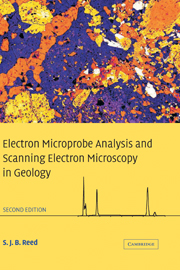Appendix
Published online by Cambridge University Press: 03 December 2009
Summary
The following figures show ED spectra of various minerals, as recorded with a thin-window Si(Li) detector. The abscissae show the energy in keV. The accelerating voltage is 20 kV and the X-ray take-off angle is 30°. Only major (α) peaks of elements are labelled; the C K peak from the carbon coating is not shown. (Note that relative peak intensities vary with accelerating voltage and, in the low-energy region, are affected by the window characteristics.) Many minerals exhibit a considerable range of compositions, which should be taken into account.
Information
- Type
- Chapter
- Information
- Publisher: Cambridge University PressPrint publication year: 2005
Accessibility standard: Unknown
Why this information is here
This section outlines the accessibility features of this content - including support for screen readers, full keyboard navigation and high-contrast display options. This may not be relevant for you.Accessibility Information
- 1
- Cited by
